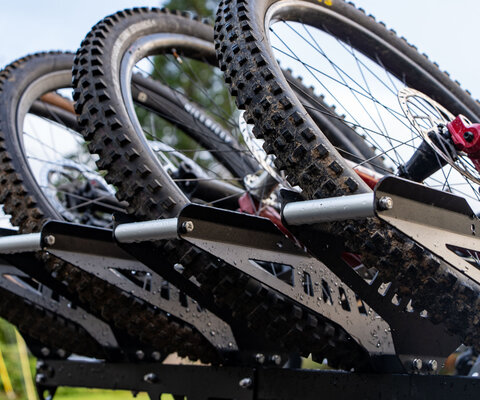
Never Wavering, Always Watching A Special Trail for an Atomic Dog
Words by Eric Brown | Photos by Courtney Nash
In December 2009, I was digging in a rough new section of trail on Galbraith Mountain, just outside of Bellingham, WA. My 6-year-old Rhodesian Ridgeback/Black Lab mix, Baker, had dug a hole off to the side, hunkered down in it, and was watching me work.
Baker was the consummate trail dog—fast, loyal, smart, and always looping back to make sure no one was left behind. A classic Ridegeback, he trusted almost no one, but once you earned that trust his loyalty never wavered. He was also a stellar trail building dog—never in the way, but always within sight. Sometimes it bordered on creepy. That dog was always watching me.
Not far off, I could hear his 8-year-old brother, Shasta—a Great Dane/Black Lab mix—chasing after a stick I had thrown down the hill as a distraction. Shasta was the yin to Baker’s yang: goofy, not very smart, and easily distracted, but equally as loving in his own deafening way. I’d probably built more trails with those two dogs than any human, and we’d certainly suffered some of the most unforgiving terrain and weather together in the process.

I finished the section and moved on to the next stretch. Baker noticed immediately, followed me at a slight distance, and dug another hole from which to oversee my work.
The new trail was a matter of necessity. Earlier in the year, a big crew of us had started on a machine-built jump trail, called Unemployment Line. “U-Line” would direct a surge of high-speed traffic down to a road, with only an old XC line to get those riders to the bottom of the hill. And so I needed a way to divert the jump line traffic off the XC trail.
But I also needed the trail for Baker. After only five years together, he was dying. We needed one final project together.
My wife first noticed Baker limping in September 2009, after she’d taken him on a long hike in the mountains east of Bellingham. He’d just recovered from ACL surgery, so we figured that was the cause. Maybe a screw was coming loose, something minor, but we took him to the vet to be safe.
The X-rays revealed much worse. Over 60 percent of Baker’s left hip had been consumed by bone cancer in a matter of months. The prognosis was fatal; we were only buying time at that point, and we didn’t even know how much.
Now, instead of being annoying, every time we’d see him skulk covertly off the couch became something precious. The way he pranced his front legs around like a showhorse whenever we came home, half growling and howling, was a gift.
By December, Baker had undergone multiple rounds of chemotherapy, but we still spent many wet nights scouting and routing the trail after work in the dark. Baker and Shasta were both tireless trail-building partners, never whining or balking at downed trees or jungle-thick vine maple. But Baker was starting to falter, unable to hike as far or long as we used to. Back at home, he was losing his appetite, a clear sign with a Ridgeback that something was wrong. My wife cooked him all kinds of mixes of ground meat and roasted chicken with rice, and each time he’d stop eating we’d double down on some other combination and keep him going a few more days. But he kept fading.
In early January of 2010, our friends at Transition Bikes sponsored a trail day. Seventy-five people showed up, and with such an incredible turnout we cut in half the trail and got a large percentage of it nearly finished. Most of the volunteers weren’t aware of Baker’s illness, but some knew and made a concerted effort to attend this particular workday. Baker and Shasta were integral parts of the local build crew.
The dogs and I continued to spend our evenings working on the trail. A couple of weeks later, on our second official volunteer work day, we tied it into the road at the bottom and made it roughly rideable to the exit—truly impressive, considering we built two-thirds of a mile in two days.
After that second trail day, I would park at the bottom and hike up to the remaining section. By this time, Baker could barely make it up the hill. At some of the steeper spots, I’d have to get behind him and give a helping push. It was at these moments I would break down and cry, knowing our time together was waning quickly. When we’d get to our work spot, he’d scratch off a little duff, lay down, and keep an eye on me.
On January 28, 2010, after several days of Baker not eating and many trips to the vet, my wife and I decided we had done all we could do: Baker was clearly suffering, so we made the difficult call to put him down. The overwhelming outpouring of support from my fellow trail builders and our friends was an indication of how much love he garnered from everyone he’d ever met, and a show of the solidarity that united every path he crossed, be they human, two-wheeled or canine. Mountain bikes can do that. So can dogs.
We finished the trial in June 2010. It embodied everything Baker had given to us, which I could only ever capture in a truly special trail for a truly special dog—an Atomic Dog.


